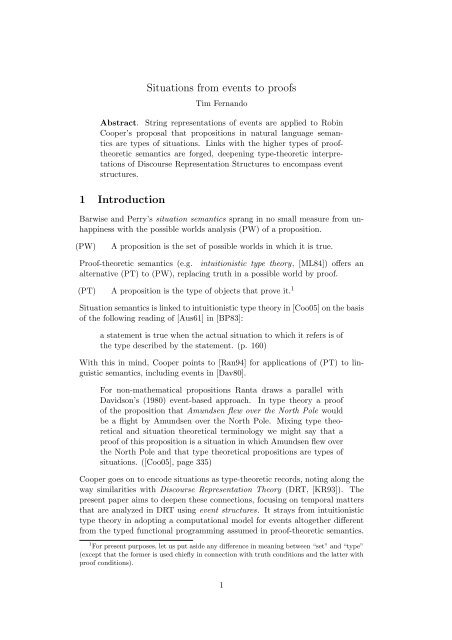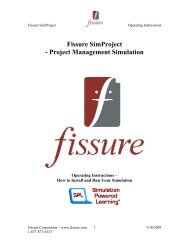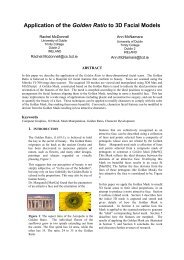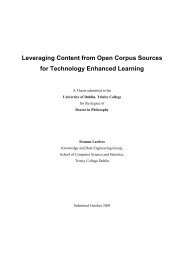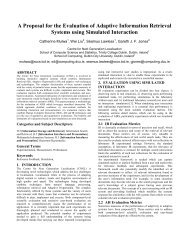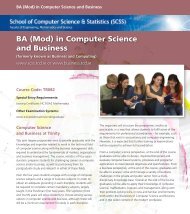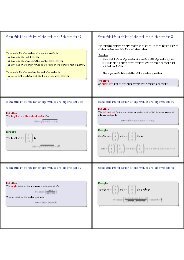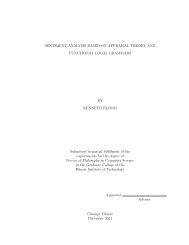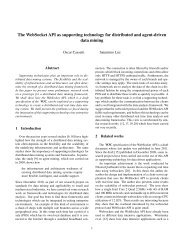Situations from events to proofs 1 Introduction
Situations from events to proofs 1 Introduction
Situations from events to proofs 1 Introduction
You also want an ePaper? Increase the reach of your titles
YUMPU automatically turns print PDFs into web optimized ePapers that Google loves.
<strong>Situations</strong> <strong>from</strong> <strong>events</strong> <strong>to</strong> <strong>proofs</strong><br />
Tim Fernando<br />
Abstract. String representations of <strong>events</strong> are applied <strong>to</strong> Robin<br />
Cooper’s proposal that propositions in natural language semantics<br />
are types of situations. Links with the higher types of prooftheoretic<br />
semantics are forged, deepening type-theoretic interpretations<br />
of Discourse Representation Structures <strong>to</strong> encompass event<br />
structures.<br />
1 <strong>Introduction</strong><br />
Barwise and Perry’s situation semantics sprang in no small measure <strong>from</strong> unhappiness<br />
with the possible worlds analysis (PW) of a proposition.<br />
(PW)<br />
A proposition is the set of possible worlds in which it is true.<br />
Proof-theoretic semantics (e.g. intuitionistic type theory, [ML84]) offers an<br />
alternative (PT) <strong>to</strong> (PW), replacing truth in a possible world by proof.<br />
(PT) A proposition is the type of objects that prove it. 1<br />
Situation semantics is linked <strong>to</strong> intuitionistic type theory in [Coo05] on the basis<br />
of the following reading of [Aus61] in [BP83]:<br />
a statement is true when the actual situation <strong>to</strong> which it refers is of<br />
the type described by the statement. (p. 160)<br />
With this in mind, Cooper points <strong>to</strong> [Ran94] for applications of (PT) <strong>to</strong> linguistic<br />
semantics, including <strong>events</strong> in [Dav80].<br />
For non-mathematical propositions Ranta draws a parallel with<br />
Davidson’s (1980) event-based approach. In type theory a proof<br />
of the proposition that Amundsen flew over the North Pole would<br />
be a flight by Amundsen over the North Pole. Mixing type theoretical<br />
and situation theoretical terminology we might say that a<br />
proof of this proposition is a situation in which Amundsen flew over<br />
the North Pole and that type theoretical propositions are types of<br />
situations. ([Coo05], page 335)<br />
Cooper goes on <strong>to</strong> encode situations as type-theoretic records, noting along the<br />
way similarities with Discourse Representation Theory (DRT, [KR93]). The<br />
present paper aims <strong>to</strong> deepen these connections, focusing on temporal matters<br />
that are analyzed in DRT using event structures. It strays <strong>from</strong> intuitionistic<br />
type theory in adopting a computational model for <strong>events</strong> al<strong>to</strong>gether different<br />
<strong>from</strong> the typed functional programming assumed in proof-theoretic semantics.<br />
1 For present purposes, let us put aside any difference in meaning between “set” and “type”<br />
(except that the former is used chiefly in connection with truth conditions and the latter with<br />
proof conditions).<br />
1
Nonetheless, the resulting account is, I will argue, compatible with the spirit,<br />
if not with the letter, of [Ran94, Coo05] and [KR93].<br />
Compatibility with possible worlds semantics is a more <strong>to</strong>rtuous affair. It<br />
will prove instructive <strong>to</strong> highlight two familiar principles associated with the<br />
view (PW) that a proposition is a set of possible worlds. The first, (CM), concerns<br />
the use Carnap and Montague make of possible worlds <strong>to</strong> bridge notions<br />
of intension (or sense) with extension (or reference).<br />
(CM)<br />
Intension is a function <strong>from</strong> possible worlds <strong>to</strong> extensions.<br />
The second, (TV), specifies the possible extensions of a sentence.<br />
(TV)<br />
Sentences refer <strong>to</strong> one of two truth values.<br />
If propositions are intensions of sentences, as we henceforth assume, then (PW)<br />
becomes an immediate consequence of (CM), (TV) and the equivalence between<br />
the space 2 W of functions <strong>from</strong> a set W <strong>to</strong> the two-element set 2 = {0, 1}<br />
and the family Pow(W ) of subsets of W . Barwise and Perry reject (TV) and<br />
an argument for (TV) they attribute <strong>to</strong> Davidson (among others) which they<br />
call “the slingshot, for reasons buried in the early his<strong>to</strong>ry of situation semantics”<br />
([BP83], page 24)] Instead, in situation semantics, a statement refers <strong>to</strong><br />
a situation (as Cooper reminds us above). The switch here <strong>from</strong> sentences <strong>to</strong><br />
statements hints at the context dependence of reference famously captured by<br />
Kaplan’s notion of character ([Kap79]) as a function <strong>from</strong> contexts <strong>to</strong> contents,<br />
the latter being the intensions characterized in (CM). In place of (CM), Barwise<br />
and Perry propose a “relational theory of meaning,” an early form of which is<br />
put as follows.<br />
The leading idea of situation semantics is that the meaning of a<br />
simple declarative sentence is a relation between utterances and described<br />
situations. The interpretation of a statement made with<br />
such a sentence on a specific occasion is the described situation.<br />
([BP83], page 19)<br />
As is clear <strong>from</strong> [Per97], this passage leaves out later developments in situation<br />
semantics, including elaborations of utterances in<strong>to</strong> pairs of situations<br />
(called discourse situations and connective situations). Compared <strong>to</strong> possible<br />
worlds, situations are much smaller; situations are partial in that, unlike possible<br />
worlds, they may fail <strong>to</strong> make an arbitrary sentence true or false.<br />
Without aspiring <strong>to</strong> be fully faithful <strong>to</strong> any particular version of situation<br />
semantics, the present paper follows situation semantics in employing situations<br />
for two purposes:<br />
(i)<br />
(ii)<br />
as alternatives <strong>to</strong> truth values in (TV), and<br />
as alternatives <strong>to</strong> possible worlds in (CM).<br />
This is not <strong>to</strong> say that we need only replace possible worlds and extensions<br />
in (CM) by situations for an account of what the intension of a sentence is.<br />
That account would be in direct conflict with propositions-as-types (PT), if<br />
2
intensions of sentences are, as we have agreed, propositions. To clarify matters,<br />
notice that (CM) implies (UR), assuming possible worlds in (CM) are relabeled<br />
“circumstances of evaluation.”<br />
(UR)<br />
The reference of a sentence is uniquely determined by the proposition<br />
the sentence expresses and the circumstances of evaluation.<br />
Reducing circumstances of evaluation <strong>from</strong> possible worlds (in (CM)) <strong>to</strong> partial<br />
situations raises the question: could there not be propositions and circumstances<br />
of evaluation that <strong>to</strong>gether underdetermine reference, contradicting<br />
(UR)? We may, of course, hardwire existence and uniqueness of reference by<br />
throwing out circumstances of evaluation that lead <strong>to</strong> non-deterministic reference.<br />
But might such circumstances not be interesting in their own right? A<br />
plausible approach <strong>to</strong> ambiguity and presupposition failure is <strong>to</strong> explore the<br />
non-determinism possible in relations, as opposed <strong>to</strong> functions (<strong>from</strong> say, (CM)<br />
or, for that matter, Kaplan). That said, if we put ambiguity and presupposition<br />
failure aside, can we speak of “the described situation”?<br />
No, or so Davidson argues in page 91 of [Dav67], where he considers sentence<br />
(S1).<br />
(S1) Amundsen flew <strong>to</strong> the North Pole in May 1926.<br />
Davidson cautions against thinking (S1) describes an event 2 because of potential<br />
complications with uniqueness; the sentence may describe several flights or “a<br />
kind of event.” In any case, the crucial point for Davidson is that the sentence is<br />
true iff “there is an event that makes it true” ([Dav67], page 91). Here Davidson<br />
calls <strong>events</strong> <strong>proofs</strong> (inasmuch as what makes a sentence true is a proof). More<br />
generally, he associates certain action sentences S with sets E(S) of <strong>events</strong> such<br />
that<br />
S is true iff there is an event e such that e ∈ E(S) . (1)<br />
Possible worlds do not appear in (1), the idea being that (1) is purely extensional,<br />
with <strong>events</strong> as particulars. Observe, however, that (1) may hold for quite<br />
unrelated pairs S and E(S). For instance, given any event ê, we can satisfy (1)<br />
by setting<br />
E(S)<br />
def<br />
=<br />
{ {ê} if S is true<br />
∅ otherwise<br />
independently of whether or not S is remotely about ê. If the “actual” world<br />
were an event, we could, of course, choose that for ê, and claim that S is in<br />
some sense about ê. Even then, however, the question remains: why speak of<br />
<strong>events</strong> if one, ê, will do?<br />
In fact, we need more than one. An event may appear in many expressions<br />
as arguments <strong>to</strong> various predicates <strong>from</strong> which E(S) is, in practice, formed.<br />
Logical form is central <strong>to</strong> [Dav67]; it is unfortunate that (1) hides the logical<br />
form behind E(S) and the possibility that e occurs many places within that<br />
2 Throughout this paper, we follow Cooper in understanding <strong>events</strong> as situations.<br />
3
form. But what if that logical form has no structure, or rather, its structure is<br />
“a<strong>to</strong>mic”? Proof-theoretic semantics provides interpretations of logical connectives<br />
but otherwise says nothing about the interpretations of a<strong>to</strong>mic expressions<br />
(which are free of connectives). Whatever one may think of logical a<strong>to</strong>mism,<br />
there is considerable linguistic interest in developing what Parsons calls suba<strong>to</strong>mic<br />
semantics, by which he means<br />
the study of those “formulas of English” that are treated as a<strong>to</strong>mic<br />
formulas in most investigations of English. The main hypothesis <strong>to</strong><br />
be investigated is that simple sentences of English contain suba<strong>to</strong>mic<br />
quantification over <strong>events</strong>. ([Par90], page ix)<br />
Significant aspects of suba<strong>to</strong>mic semantics concern temporality. Indeed, it is<br />
difficult <strong>to</strong> see anything beyond the temporal traces of <strong>events</strong> in the event<br />
structures of [KR93].<br />
A bit of temporal logic (aka Priorean tense logic) provides a glimpse of what<br />
the notions of intension, extension and circumstances of evaluation become<br />
below. Let Ŝ be the formula<br />
previous(ϕ) ∧ (ψ until χ)<br />
over the a<strong>to</strong>mic propositions ϕ, ψ and χ. Let us interpret Ŝ relative <strong>to</strong> a discrete<br />
timeline such as the integers (with well-defined previous and next moments).<br />
Under the standard Kripke semantics for temporal logic (e.g. [Eme92]), Ŝ is<br />
true at a moment now iff<br />
previous <strong>to</strong> now, ϕ is true and ψ is true <strong>from</strong> now until χ is true.<br />
Accordingly, an event proving Ŝ is a string of the form<br />
ϕ now, ψ ψ n χ (for some n ≥ 0)<br />
with length (n + 3), specifying ϕ one moment before now and ψ <strong>from</strong> now until<br />
χ. We enclose snapshots in boxes and string these <strong>to</strong>gether in<strong>to</strong> film strips.<br />
Using the notation in (1), we associate with Ŝ the event-type<br />
E(Ŝ) = ϕ now, ψ ψ<br />
∗<br />
χ<br />
= { ϕ now, ψ χ , ϕ now, ψ ψ χ , ϕ now, ψ ψ ψ χ , . . .} .<br />
Next, we say a string s occurs in a string c if we can form s <strong>from</strong> c by selectively<br />
deleting boxes at the beginning and end of c, as well as various occurrences of<br />
formulas in c. For example,<br />
ϕ now, ψ ψ χ occurs in ϕ, ψ ϕ, χ now, ϕ, ψ ϕ, ψ ϕ, χ (2)<br />
as can be seen by deleting everything underlined in<br />
ϕ, ψ ϕ, χ now, ϕ, ψ ϕ, ψ ϕ, χ .<br />
4
We can then relativize (1) <strong>to</strong> a circumstance of evaluation c, formulated as a<br />
string, by agreeing that<br />
S occurs in c<br />
def<br />
⇐⇒ (∃e ∈ E(S)) e occurs in c . (3)<br />
It follows <strong>from</strong> (2) and (3) that<br />
Ŝ also occurs in<br />
this time because<br />
Ŝ occurs in ϕ, ψ ϕ, χ now, ϕ, ψ ϕ, ψ ϕ, χ .<br />
c 1 = ϕ, ψ now, ϕ, ψ ψ, χ ϕ, χ ϕ, ψ ϕ, ψ<br />
ϕ now, ψ χ and ϕ now, ψ ψ χ both occur in c 1 .<br />
We define the c-extension of S, ext(S, c), <strong>to</strong> be the set of strings in E(S) that<br />
occur in c<br />
ext(S, c)<br />
def<br />
= {s ∈ E(S) | s occurs in c}<br />
so that<br />
S occurs in c iff ext(S, c) ≠ ∅ .<br />
As ext(S, c) need not be a single<strong>to</strong>n {s}, we ought perhaps not speak of reference,<br />
leaving that <strong>to</strong> what Austin calls demonstrative conventions. If reference<br />
is not fixed in (3), then (3) must, of course, fall short of Barwise and Perry’s<br />
reading of Austinian truth (quoted by Cooper). On the other hand, the intension/type<br />
E(Ŝ) described by Ŝ above is in harmony with Kripke semantics<br />
for Ŝ, formulated in terms of truth at worlds, insofar as every world w is fully<br />
determined by a set E w of <strong>events</strong>, and<br />
Ŝ is true at w iff E(Ŝ) ∩ E w ≠ ∅ .<br />
In place of the Carnap-Montague picture (CM) of intension as a function <strong>from</strong><br />
possible worlds <strong>to</strong> extensions, the intension of S is identified with the set E(S)<br />
of possible values (extensions) of S, some subset of which get realized in a<br />
circumstance of evaluation.<br />
The strings we build below are, in general, designed <strong>to</strong> ground the higher<br />
types of proof-theoretic semantics in finite observations over time ([Fer04]).<br />
But are we not, by working with strings, smuggling an assumption of discrete<br />
time that for all we know, is unfounded? In section 2, we link discreteness <strong>to</strong><br />
the assumption that our observations are finite, and construct arbitrary event<br />
structures such as the real line <strong>from</strong> inverse limits of strings. Whereas <strong>events</strong> for<br />
Davidson are particulars, our strings are representations that can be embedded<br />
in incompatible circumstances of evaluation. In section 3, we study explicit and<br />
contextual entailments, treating strings as both extensions and circumstances of<br />
evaluation. These two roles of strings are related in section 4 <strong>to</strong> proof-theoretic<br />
semantics.<br />
5
2 Event <strong>to</strong>kens and time in languages<br />
Let us henceforth call a set of strings a language (following the cus<strong>to</strong>m in<br />
formal language theory) and temporal formulas fluents (following the cus<strong>to</strong>m<br />
in AI since [MH69]). The strings we are interested in are sequences of sets of<br />
fluents, enclosed in boxes <strong>to</strong> reinforce the intuition of snapshots arranged in<strong>to</strong><br />
a movie. For example, we can portray the phrase rain <strong>from</strong> dawn <strong>to</strong> dusk by<br />
the set<br />
rain, dawn rain ∗ rain, dusk<br />
= { rain, dawn rain n rain, dusk | n ≥ 0}<br />
of strings rain, dawn rain n rain, dusk of length n + 2 that describe n + 2<br />
successive moments of time (for n ≥ 0), each with rain, the first at dawn<br />
and the last at dusk. The different values of n support different levels of<br />
temporal granularity: the larger the n, the finer the grain. It is not obvious,<br />
however, that we should think of each of these infinitely many strings<br />
as distinct <strong>events</strong>. Surely we can reduce the infinite language <strong>to</strong> some finite<br />
core that captures its essence: three snapshots, rain, dawn , rain and<br />
rain, dusk , arranged in a particular order.<br />
Indeed, it is tempting <strong>to</strong> reduce<br />
every string rain, dawn rain n rain, dusk with n ≥ 1 <strong>to</strong> the string<br />
rain, dawn rain rain, dusk of length 3. Let us define, in general, the interval<br />
reduction ir(s) of a string s inductively<br />
⎧<br />
⎨<br />
ir(s)<br />
def<br />
=<br />
⎩<br />
s if length(s) ≤ 1<br />
ir(as ′ ) if s = aas ′<br />
a ir(a ′ s ′ ) if s = aa ′ s ′ where a ≠ a ′<br />
(for all sets a, a ′ of fluents), reducing a block aa of two a’s <strong>to</strong> one, in line with<br />
the dictum “no time without change” ([KR93], page 674).<br />
We can represent intervals by fluents and the thirteen basic interval relations<br />
of [All83], listed in Table 1, by strings derived <strong>from</strong> ir and a natural form of<br />
conjunction between languages L and L ′ . The superposition L&L ′ of L and L ′<br />
consists of the componentwise union of strings in L and L ′ of the same length<br />
L&L ′<br />
def<br />
= ⋃ n≥0{(a 1 ∪ b 1 ) · · · (a n ∪ b n ) | a 1 · · · a n ∈ L and b 1 · · · b n ∈ L ′ }<br />
([Fer04]). For example,<br />
rain, dawn rain ∗ rain, dusk = rain + & ( dawn □ ∗ dusk )<br />
= rain + & dawn □ + & □ + dusk<br />
where L + def = LL ∗ (and parentheses are suppressed, as & is associative). To<br />
loosen the tight temporal overlap between L and L ′ in L&L ′ , we pad L and L ′<br />
<strong>to</strong> the left and right by empty boxes □ (giving □ ∗ L□ ∗ and □ ∗ L ′ □ ∗ ) and then<br />
6
ϕ before ψ ϕ □ ψ ϕ after ψ ψ □ ϕ<br />
ϕ meets ψ ϕ ψ ϕ met-by ψ ψ ϕ<br />
ϕ contains ψ ϕ ϕ, ψ ϕ ϕ finished-by ψ ϕ ϕ, ψ<br />
ϕ started-by ψ ϕ, ψ ϕ ϕ equals ψ ϕ, ψ<br />
ϕ overlapped-by ψ ψ ϕ, ψ ϕ ϕ finishes ψ ψ ϕ, ψ<br />
ϕ overlaps ψ ϕ ϕ, ψ ψ ϕ during ψ ψ ϕ, ψ ψ<br />
ϕ starts ψ ϕ, ψ ψ<br />
Table 1: Allen relations ([All83]) as strings<br />
unpad their superposition. That is, we define the loose superposition L& □ L ′ of<br />
L and L ′ by<br />
L& □ L ′<br />
def<br />
= unpad(□ ∗ L□ ∗ & □ ∗ L ′ □ ∗ )<br />
where unpad(s) is s with all initial and final □’s stripped off unless s = □<br />
⎧<br />
⎨ s<br />
unpad(s)<br />
def<br />
=<br />
⎩<br />
if s = □ or<br />
s neither begins nor ends with □<br />
unpad(s ′ ) if s = □s ′ or else if s = s ′ □ .<br />
and unpad(L) def = {unpad(s) | s ∈ L}. Now, we can generate the thirteen strings<br />
representing the Allen relations in Table 1 by<br />
ir(ir −1 ( ϕ ) & □ ir −1 ( ψ )) = ir( ϕ + & □ ψ + )<br />
= ir(unpad(□ ∗ ϕ + □ ∗ & □ ∗ ψ + □ ∗ ))<br />
= ϕ (□ + ɛ) ψ + ψ (□ + ɛ) ϕ +<br />
( ϕ + ɛ + ψ ) ϕ, ψ ( ϕ + ɛ + ψ )<br />
(where + is choice/union and ɛ is the null string of length 0).<br />
What about relations between more than two intervals? Take the real line<br />
(R,
in<strong>to</strong> the string<br />
r 1 □ r 2 □ · · · □ r n<br />
with empty boxes as place-holders for the uncountably many points sandwiched<br />
between r i and r i+1 . We can construct (R,
(P 1 ) e < e ′ implies not e ′ < e<br />
(P 2 ) e < e ′ < e ′′ implies e < e ′′<br />
(P 3 ) e ○ e<br />
(P 4 ) e ○ e ′ implies e ′ ○ e<br />
(P 5 ) e < e ′ implies not e ○ e ′<br />
(P 6 ) e 1 < e 2 ○ e 3 < e 4 implies e 1 < e 4<br />
(P 7 ) e < e ′ or e ○ e ′ or e ′ < e<br />
Table 2: Postulates for event structures ([KR93], page 667)<br />
in Table 2. 3<br />
equivalence<br />
By (P 7 ), (P 5 ) and (P 4 ), we can define ○ <strong>from</strong> < through the<br />
e ○ e ′ iff neither e < e ′ nor e ′ < e .<br />
In cases where ○ is = on E, < is a linear order. But in general, we<br />
(i)<br />
form sets of pairwise overlapping <strong>events</strong>, collecting them in<br />
O(○)<br />
def<br />
= {i ⊆ E | (∀e, e ′ ∈ i) e ○ e ′ }<br />
(ii)<br />
lift < existentially <strong>to</strong> O(○), defining for i, i ′ ∈ O(○),<br />
i < O i ′<br />
def<br />
⇔ (∃e ∈ i)(∃e ′ ∈ i ′ ) e < e ′<br />
(iii)<br />
equate temporal instants with ⊆-maximal elements of O(○)<br />
I(○)<br />
def<br />
= {i ∈ O(○) | (∀i ′ ∈ O(○)) i ⊆ i ′ implies i = i ′ }<br />
and say e occurs at i if e ∈ i.<br />
Theorem (Kamp). < O linearly orders I(○) and for each e ∈ E,<br />
{i ∈ I(○) | e ∈ i}<br />
is a < O -interval (i.e. for all i, j, k ∈ I(○), if e ∈ j, e ∈ k and j < O i < O k then<br />
e ∈ i).<br />
How do event structures and Kamp’s theorem above relate <strong>to</strong> Φ-points?<br />
Given a Φ-point p, let us form the triple 〈E p , < p , ○ p 〉 by collecting fluents with<br />
interval temporal profiles in<br />
E p<br />
def<br />
= {ϕ ∈ Φ | p({ϕ}) = ϕ }<br />
3 The first two postulates are superfluous. (P 1 ) is derivable <strong>from</strong> (P 2 ), (P 3 ) and (P 5 ); and<br />
(P 2) <strong>from</strong> (P 3) and (P 6).<br />
9
and (with Table 1 in mind) setting<br />
ϕ < p ψ<br />
ϕ ○ p ψ<br />
def ⇔ p({ϕ, ψ}) ∈ ϕ (□ + ɛ) ψ (4)<br />
def ⇔ p({ϕ, ψ}) ∈ ( ϕ + ɛ + ψ ) ϕ, ψ ( ϕ + ɛ + ψ ). (5)<br />
for all ϕ, ψ ∈ Φ. For instance, if p is the point p R for the real line, then E p is<br />
R, < p is < and ○ p is = on R. It is easy <strong>to</strong> verify that for every Φ-point p,<br />
〈E p , < p , ○ p 〉 is an event structure.<br />
How do we resolve the choices in (4) and (5)? Given an event structure<br />
〈E,
(i)<br />
every (finite or infinite) subset X of E <strong>to</strong><br />
X +<br />
def<br />
= X ∪ {past(e) | e ∈ X and (∃e ′ ) e ′ < e} ∪<br />
{future(e) | e ∈ X and (∃e ′ ) e < e ′ }<br />
(ii) ○ <strong>to</strong> overlap ○ + on E + , setting for all e, e ′ ∈ E,<br />
e ○ + e ′<br />
def<br />
⇔ e ○ e ′<br />
with past(e) and future(e) given by existential quantification<br />
past(e) ○ + e ′<br />
future(e) ○ + e ′<br />
past(e) ○ + future(e ′ )<br />
def<br />
⇔ (∃e ′′ < e) e ′′ ○ e ′<br />
def<br />
⇔ (∃e ′′ > e) e ′′ ○ e ′<br />
def<br />
⇔ (∃e ′′ < e)(∃e ′′′ > e ′ ) e ′′ ○ e ′′′<br />
and so on, and<br />
(iii)<br />
< <strong>to</strong> precedence < + on E + , defining < + <strong>to</strong> be the union<br />
< ∪ {(past(e), e ′ ) ∈ E + × E + | not past(e) ○ + e ′ }<br />
∪ {(e, future(e ′ )) ∈ E + × E + | not e ○ + future(e ′ )}<br />
∪ {(past(e), future(e ′ )) ∈ E + × E + | not past(e) ○ + future(e ′ )}<br />
so that for all x, y ∈ E + ,<br />
x < + y iff neither x ○ + y nor y < + x .<br />
One can show that for every subset X of E, 〈X + , < X + , ○ X + 〉 is an event structure,<br />
where < X + and ○ X + are the restrictions of < + and ○ + <strong>to</strong> X + , respectively<br />
< X +<br />
def<br />
= < + ∩ (X + × X + ) and ○ X +<br />
def<br />
= ○ + ∩ (X + × X + ) .<br />
We can then form a compaction p of 〈E,
Then we would expect that for the negation ϕ of ϕ,<br />
p({ϕ}) = ϕ □ ϕ<br />
which implies ϕ ∉ E p . For partial snapshots, it is convenient <strong>to</strong> explicitly represent<br />
negations, stepping beyond event-occurrences within an event structure<br />
<strong>to</strong> event-types as languages.<br />
3 Situation-types and constraints as languages<br />
If we &-superpose rain, dawn rain ∗ rain, dusk<br />
with □ + noon □ + , we get<br />
rain, dawn rain ∗ rain,noon rain ∗ rain, dusk<br />
which filters out the string rain, dawn rain, dusk of length 2, and fleshes<br />
out the remaining strings in rain, dawn rain + rain, dusk by including noon<br />
in the middle. To capture the growth of information here, let us say that L<br />
subsumes L ′ and write L ☎ L ′ if the superposition of L and L ′ includes L<br />
L ☎ L ′<br />
def<br />
⇐⇒ L ⊆ L&L ′<br />
(roughly: L is at least as informative as L ′ over the same temporal stretch).<br />
Conflating a string s with the single<strong>to</strong>n language {s}, it follows that L subsumes<br />
L ′ exactly if each string in L subsumes some string in L ′<br />
L ☎ L ′ iff (∀s ∈ L)(∃s ′ ∈ L ′ ) s ☎ s ′<br />
where ☎ holds between strings of the same length related componentwise by<br />
inclusion<br />
a 1 a 2 · · · a n ☎ b 1 b 2 · · · b m iff n = m and a i ⊇ b i for 1 ≤ i ≤ n .<br />
For example, ϕ, ψ ☎ ϕ ☎ ϕ + ψ . As a type with instances s ∈ L, a<br />
language L is essentially a disjunction ∨ s∈L<br />
s of conjunctions s (as is clear <strong>from</strong><br />
the model-theoretic interpretations spelled out in [Fer04]).<br />
To express requirements such as occurrences of dawn and dusk sandwich<br />
noon<br />
let us define<br />
(i)<br />
(ii)<br />
dawn □ ∗ dusk ⇒ □ + noon □ + ,<br />
for any string s, a fac<strong>to</strong>r of s <strong>to</strong> be a string x such that s = uxv for<br />
some (possibly null) strings u and v, and<br />
for any languages L and L ′ , the constraint L ⇒ L ′ <strong>to</strong> be the set of<br />
strings s such that every fac<strong>to</strong>r of s that subsumes L also subsumes L ′<br />
L ⇒ L ′<br />
def<br />
= {s ∈ Pow(Φ) ∗ | (for every fac<strong>to</strong>r x of s)<br />
x ☎ L implies x ☎ L ′ }<br />
12
([BK03, FN05]). With ⇒, we can define the ϕ-bivalent language<br />
□ ⇒ ϕ + ϕ<br />
consisting of strings a 1 a 2 · · · a n ∈ Pow(Φ) ∗ such that for each i <strong>from</strong> 1 <strong>to</strong> n<br />
(inclusive), ϕ ∈ a i or ϕ ∈ a i . While we may want <strong>to</strong> work with strings that do<br />
not belong <strong>to</strong> this language (allowing a string <strong>to</strong> be silent on ϕ), it makes sense<br />
<strong>to</strong> restrict our <strong>events</strong> <strong>to</strong> strings in the ϕ-consistent language<br />
ϕ, ϕ ⇒ ∅<br />
requiring that no symbol in a string contain both ϕ and its negation ϕ. Similarly,<br />
<strong>to</strong> require that a fluent r occur at most once in a string, the constraint<br />
r □ ∗ r ⇒ ∅<br />
precludes the occurrence of r in two different positions in a string. We may<br />
impose this on r equal <strong>to</strong> some moment now or other.<br />
A Reichenbachian approach <strong>to</strong> tense and aspect locates the event time E<br />
relative <strong>to</strong> not only a speech time S but also a reference time R ([Rei47]). To<br />
see the point behind R, consider the pair (S2), (S3). (The oddness of (S3) is<br />
marked by the superscript ? .)<br />
(S2)<br />
(S3)<br />
Pat left Dublin but is back (in Dublin).<br />
? Pat has left Dublin but is back (in Dublin).<br />
In both (S2) and (S3), Pat’s departure L 0 <strong>from</strong> Dublin<br />
L 0<br />
def<br />
= L(Pat leave Dublin) ☎ in(p, d) □ ∗ in(p, d)<br />
(where the fluent in(p, d) is read Pat-in-Dublin) precedes the speech time S<br />
L(Pat left Dublin) ☎ L 0 □ ∗ S<br />
L(Pat has left Dublin) ☎ L 0 □ ∗ S .<br />
R allows us <strong>to</strong> distinguish L(Pat left Dublin) <strong>from</strong> L(Pat has left Dublin),<br />
coinciding with the end of L 0 in the former case<br />
and with S in the latter<br />
L(Pat left Dublin) ☎ in(p, d) □ ∗ in(p, d), R □ ∗ S (9)<br />
L(Pat has left Dublin) ☎ in(p, d) □ ∗ in(p, d) □ ∗ R, S . (10)<br />
In general, we apply aspectual and tense opera<strong>to</strong>rs in sequence, forming, for<br />
instance,<br />
L(Pat left Dublin) = Past(Simp(L 0 ))<br />
L(Pat has left Dublin) = Pres(Perf(L 0 ))<br />
13
with tense opera<strong>to</strong>rs for the past and present applied after opera<strong>to</strong>rs for simple<br />
and perfect aspect. If an event with temporal projection E is represented by a<br />
language L, we get three aspectual opera<strong>to</strong>rs on L.<br />
Simp(L)<br />
Prog(L)<br />
Perf(L)<br />
def<br />
= L & □ ∗ R (i.e. E = R)<br />
def<br />
= L & □ + R □ + (i.e. R contained in E)<br />
def<br />
= L□ ∗ R (i.e. E < R)<br />
As a position <strong>from</strong> which <strong>to</strong> view the event represented by L, R says in the case<br />
of Simp(L), that the event has reached completion; in the case of Prog(L),<br />
that it has not quite gotten there yet but is on its way; and in Perf(L), that it<br />
is his<strong>to</strong>ry. Tense then locates S relative <strong>to</strong> R, coinciding with R for the present<br />
Pres(L)<br />
def<br />
= (L & □ S ) ∩ ‘R = S’<br />
and coming after R for the past<br />
Past(L)<br />
def<br />
= (L & □ S ) ∩ ‘R < S’<br />
where ‘R = S’ is the set of strings<br />
( R + S ) ⇒ R, S<br />
in which R and S co-occur, and ‘R < S’ is the set of strings<br />
( R, S + S □ ∗ R ) ⇒ ∅<br />
in which R precedes S.<br />
To account for the contrast between (S2) and (S3), it suffices that in(p, d)<br />
persist forward in L(Pat has left Dublin)<br />
but not in L(Pat left Dublin)<br />
L(Pat has left Dublin) ☎ □ + in(p, d), S (11)<br />
L(Pat left Dublin) ̸☎ □ + in(p, d), S . (12)<br />
If the postcondition in(p, d) of L 0 were <strong>to</strong> flow up <strong>to</strong> R, then we can derive (11)<br />
<strong>from</strong> (10) while respecting (12), given (9). Independent confirmation that R is<br />
a barrier <strong>to</strong> persistence (forward) is provided by the non-entailment<br />
where<br />
Pat was in Dublin ̸|− Pat is in Dublin<br />
L(Pat was in Dublin) ☎ in(p, d) ∗ in(p, d), R □ ∗ S .<br />
If in(p, d) were <strong>to</strong> spill past R and over <strong>to</strong> S, in(p, d), S would mean Pat is in<br />
Dublin.<br />
14
We can express the persistence of an inertial fluent ϕ by introducing a<br />
non-inertial fluent fϕ that marks the application of a force against ϕ. The<br />
constraint<br />
ϕ □ ⇒ (□ ϕ + fϕ □ + R □)<br />
then says that ϕ persists <strong>to</strong> the next moment unless some force is applied against<br />
ϕ or R coincides with ϕ. 5 The persistence of the postcondition in(p, d) of L 0<br />
in (11) arises <strong>from</strong> the assumption that no force is applied against the fluent<br />
at the end of L 0 . Instances where a force is applied against the postcondition<br />
surface as cases such as (S4) of non-persistence.<br />
(S4) Pat has been <strong>to</strong> Dublin (̸|− Pat is in Dublin)<br />
The formation of the Reichenbachian perfect extends the event’s temporal<br />
stretch, yielding a situation greater than the event. To extract the information<br />
contained in a string, it is useful <strong>to</strong> relax the strict temporal match-up in<br />
L ☎ L ′ ,<br />
weakening its second argument L ′ <strong>to</strong> the set L ′□ of strings in L ′ with any<br />
number of leading and trailing □’s deleted or added<br />
L ′ □<br />
def<br />
= □ ∗ unpad(L ′ )□ ∗<br />
= {s | unpad(s) ∈ unpad(L ′ )} .<br />
We define weak subsumption ◮ by<br />
L◮L ′<br />
def<br />
⇐⇒<br />
L ☎ L ′ □<br />
iff unpad(L) ⊆ L& □ L ′ .<br />
Weak subsumption compares information content in the same way as ☎<br />
L◮L ′ iff (∀s ∈ L)(∃s ′ ∈ L ′ ) s◮s ′ .<br />
but without insisting that strings have the same length<br />
s◮s ′ iff (∃s ′′ ) unpad(s ′′ ) = unpad(s ′ ) and s ☎ s ′′ .<br />
5 Forces that make ϕ true appear in the backward persistence constraint<br />
□ ϕ ⇒ ( ϕ □ + fϕ □)<br />
stating that if ϕ is true, it must have been so previously or else was forced <strong>to</strong> be true. The<br />
fluents fϕ and fϕ were assumed identical in [FN05]. Differentiating them allows us <strong>to</strong> formulate<br />
the constraint “succeed unless opposed”<br />
(suo) fϕ □ ⇒ (□ ϕ + fϕ □)<br />
saying an unopposed force on ϕ brings ϕ about at the next moment. Were fϕ and fϕ the<br />
same, (suo) would have no bite (denoting, as it would, the universal language Pow(Φ) ∗ ).<br />
An early paper on the relevance of inertia <strong>to</strong> linguistics is [Dow86]; later works include<br />
[Ste00] and [LH05], where a different formal approach <strong>to</strong> inertia is pursued.<br />
15
Insofar as L◮L ′ says every instance of L contains some instance of L ′ , it is natural<br />
<strong>to</strong> say L ′ occurs in L when L◮L ′ . This generalizes the notion of occurrence<br />
discussed in the introduction.<br />
Having weakened the second argument of ☎, we now strengthen its first argument<br />
with background contextual information encoded by a set C ⊆ Pow(Φ) ∗<br />
of strings. To illustrate, an event L = rain,now of raining now updates a background<br />
<strong>to</strong> give<br />
C = (□ + rain + rain ) + & (□ + now □ + )<br />
C[L] = (□ + rain + rain ) ∗ rain,now (□ + rain + rain ) ∗ .<br />
Evidently, neither the intersection C ∩ L nor the superposition C&L will do for<br />
the result C[L] of updating C by L. Combining ∩ and &, let<br />
C[L]<br />
def<br />
= {s ∈ C | s◮L}<br />
= (L □ &C) ∩ C .<br />
Not only does context grow eliminatively, C[L] ⊆ C, but C[L]◮L, so that we<br />
can strengthen ◮ <strong>to</strong> a relation |− C sensitive <strong>to</strong> C, defining<br />
L |− C L ′<br />
def<br />
⇐⇒ C[L]◮L ′<br />
([Fer06]).<br />
4 On <strong>to</strong> proof-theoretic semantics<br />
How do the relations ☎ and |− C square with proof-theoretic semantics? More<br />
notation is convenient. Given a string c and a language L, let<br />
(i)<br />
E L (c) be the set of strings in L that c subsumes<br />
E L (c)<br />
def<br />
= {s ∈ L | c ☎ s}<br />
(ii)<br />
ext(L, c) be the set of strings in L that occur in c<br />
ext(L, c)<br />
def<br />
= {s ∈ L | c ◮ s}<br />
(iii)<br />
e L (c) be some element of E L (c) if E L (c) ≠ ∅ else e L (c) = c, and<br />
(iv) e(L, c) be some element of ext(L, c) if ext(L, c) ≠ ∅ else e(L, c) = c.<br />
It follows that<br />
L ☎ L ′ iff (∀x ∈ L) E L ′(x) ≠ ∅<br />
iff (∀x ∈ L) e L ′(x) ∈ L ′<br />
16
and<br />
L |− C L ′ iff (∀x ∈ C)(∀y ∈ ext(L, x)) ext(L ′ , x) ≠ ∅<br />
iff (∀x ∈ C)(∀y ∈ ext(L, x)) e(L ′ , x) ∈ L ′ .<br />
Adopting the familiar sequent format Γ ↦−→ Θ for an assertion (or judgment)<br />
Θ based on assumptions (or context) Γ, we might then express L ☎ L ′ as<br />
and L |− C L ′ as<br />
x ∈ L ↦−→ e L ′(x) ∈ L ′ (13)<br />
x ∈ C, y ∈ ext(L, x) ↦−→ e(L ′ , x) ∈ L ′ . (14)<br />
If we are <strong>to</strong> replace e L ′(x) and e(L ′ , x) by terms t(x) and t ′ (x, y) that can be<br />
formed through a system of rules, we must beef L ′ up <strong>to</strong> E L ′(x) and ext(L ′ , x)<br />
respectively, 6 resulting in<br />
for (13) and<br />
x ∈ L ↦−→ t(x) ∈ E L ′(x) (15)<br />
x ∈ C, y ∈ ext(L, x) ↦−→ t ′ (x, y) ∈ ext(L ′ , x) (16)<br />
for (14). In both (15) and (16), the first variable typed, x, relativizes the<br />
languages of all other terms appearing in the sequent (L ′ in (15), and L, L ′ in<br />
(16)). To isolate the variable x <strong>to</strong> the left of ↦−→, we can put (16) as<br />
x ∈ C ↦−→ (λy ∈ ext(L, x)) t ′ (x, y) ∈ ext(L, x) → ext(L ′ , x)<br />
with a function (λy ∈ ext(L, x)) t ′ (x, y) <strong>to</strong> the right of ↦−→. The example of<br />
e(L ′ , x) <strong>from</strong> (14) for t ′ (x, y) suggests the function need not consult y during its<br />
computation; the typing y ∈ ext(L, x) serves simply <strong>to</strong> ensure that the search<br />
for a string in ext(L ′ , x) succeeds, provided L |− C L ′ . At any rate, we need not<br />
worry about termination of the computation, so long as we bound the search<br />
<strong>to</strong> strings occurring in (or, in the case of t(x), subsumed by) x.<br />
With these functions in mind, let us call a function f on strings over the<br />
alphabet Pow(Φ) a ☎-map if for all s ∈ Pow(Φ) ∗ , s ☎ f(s). If we collect in<br />
L ☎ → L ′ all ☎-maps that send strings in L <strong>to</strong> strings in L ′<br />
f ∈ L ☎ → L ′<br />
def<br />
⇐⇒ f is a ☎-map and (∀s ∈ L) f(s) ∈ L ′<br />
then we can reduce L ☎ L ′ <strong>to</strong> the non-emptiness of L → ☎ L ′<br />
L ☎ L ′ iff L → ☎ L ′ is inhabited (i.e. non-empty) .<br />
6 This is because we can no longer rely on the fact that for all languages L and strings x,<br />
e L(x) ☎ x and e(L, x)◮x.<br />
17
Weakening subsumption ☎, we define a function f on strings over the alphabet<br />
Pow(Φ) <strong>to</strong> be a ◮-map if for all s ∈ Pow(Φ) ∗ , s◮f(s). Then L |− C L ′ reduces<br />
<strong>to</strong> the existence of a ◮-map <strong>from</strong> C[L] <strong>to</strong> L ′<br />
L |− C L ′ iff there is a ◮-map f such that (∀s ∈ C[L]) f(s) ∈ L ′ .<br />
We can go beyond any single (finite) string c <strong>to</strong> a set C of strings that<br />
approximates a world, assuming C is ◮-directed in that for all c, c ′ ∈ C, there<br />
exists c ′′ ∈ C such that c ′′ ◮c and c ′′ ◮c ′ . Forming the union of their extensions<br />
def<br />
ext(L, C) = ⋃<br />
ext(L, c) ,<br />
it is natural <strong>to</strong> modify (16) <strong>to</strong><br />
c∈C<br />
x ∈ C, y ∈ ext(L, x) ↦−→ ˆt(x, y) ∈ (∃z ∈ C) ext(L ′ , z) (17)<br />
for which the problem is how <strong>to</strong> bound the variable z. Our approach of building<br />
an inference relation |− C by incorporating background assumptions C in<strong>to</strong><br />
the first argument of ◮ shifts the complexity <strong>from</strong> proof terms t, t ′ , . . . <strong>to</strong> C.<br />
Constraints L ⇒ L ′ are useful in forming C, and involve ☎-maps insofar as<br />
s ∈ L ⇒ L ′ iff {x ∈ Fac(s) | x ☎ L} ☎ L ′<br />
where Fac(s) is the set of fac<strong>to</strong>rs of s<br />
Fac(s)<br />
def<br />
= {x ∈ Pow(Φ) ∗ | (∃u, v ∈ Pow(Φ) ∗ ) s = uxv} .<br />
There are variants of ⇒ that apply <strong>to</strong> various cases of (17), described in [FN05],<br />
drawing on methods in [BK03].<br />
Acknowledgments<br />
This paper is an update on my invited talk at SPR 2001. I thank the organizers<br />
of that workshop and edi<strong>to</strong>rs of this volume, especially Kepa Korta for his<br />
patience. I am grateful also <strong>to</strong> Yukinori Takubo, Takao Gunji, Ikumi Imani,<br />
Hiroshi Mi<strong>to</strong> and Norihiko Ogata for much appreciated interest.<br />
References<br />
[All83] James F. Allen. Maintaining knowledge about temporal intervals. Communications<br />
of the ACM, 26(11):832–843, 1983.<br />
[Aus61] John L. Austin. Truth. In J.O. Urmson and G.J. Warncock, edi<strong>to</strong>rs,<br />
Philosophical Papers. Oxford University Press, 1961.<br />
[BK03] Kenneth R. Beesley and Lauri Karttunen.<br />
CSLI Publications, Stanford, 2003.<br />
Finite State Morphology.<br />
[BP83] Jon Barwise and John Perry. <strong>Situations</strong> and Attitudes. MIT Press,<br />
Cambridge, Mass., 1983.<br />
18
[Coo05] Robin Cooper. Austinian truth, attitudes and type theory. Research<br />
on Language and Computation, 3(4):333–362, 2005.<br />
[Dav67] Donald Davidson. The logical form of action sentences. In Nicholas<br />
Rescher, edi<strong>to</strong>r, The Logic of Decision and Action, pages 81–95. University<br />
of Pittsburgh Press, 1967. Reprinted in [Dav80].<br />
[Dav80] Donald Davidson. Essays on Actions and Events. Clarendon Press,<br />
Oxford, 1980.<br />
[Dow86] David R. Dowty. The effects of aspectual class on the temporal structure<br />
of discourse: semantics or pragmatics? Linguistics and Philosophy,<br />
9:37–61, 1986.<br />
[Eme92] E. Allen Emerson. Temporal and modal logic. In J. van Leeuwen,<br />
edi<strong>to</strong>r, Handbook of Theoretical Computer Science, volume B: Formal<br />
Methods and Semantics, pages 995–1072. MIT Press, 1992.<br />
[Fer04] Tim Fernando. A finite-state approach <strong>to</strong> <strong>events</strong> in natural language<br />
semantics. Journal of Logic and Computation, 14(1):79–92, 2004.<br />
[Fer06] Tim Fernando. Finite-state temporal projection. In Proc. 11th International<br />
Conference on Implementation and Application of Au<strong>to</strong>mata,<br />
Lecture Notes in Computer Science 4094, pages 230–241. Springer-<br />
Verlag, 2006.<br />
[FN05] T. Fernando and R. Nairn. Entailments in finite-state temporality. In<br />
Proc. 6th International Workshop on Computational Semantics, pages<br />
128–138. Tilburg University, 2005.<br />
[Kap79] David Kaplan. On the logic of demonstratives. Journal of Philosophical<br />
Logic, 8(1), 1979.<br />
[KR93] H. Kamp and U. Reyle. From Discourse <strong>to</strong> Logic. Kluwer Academic<br />
Publishers, Dordrecht, 1993.<br />
[LH05] M. van Lambalgen and F. Hamm. The Proper Treatment of Events.<br />
Blackwell, 2005.<br />
[MH69] J. McCarthy and P. Hayes. Some philosophical problems <strong>from</strong> the<br />
standpoint of artificial intelligence. In M. Meltzer and D. Michie,<br />
edi<strong>to</strong>rs, Machine Intelligence 4, pages 463–502. Edinburgh University<br />
Press, 1969.<br />
[ML84] Per Martin-Löf. Intuitionistic Type Theory. Bibliopolis, Napoli, 1984.<br />
Notes by Giovanni Sambin of a series of lectures given in Padua, June<br />
1980.<br />
[Par90] Terence Parsons. Events in the Semantics of English: A Study in Suba<strong>to</strong>mic<br />
Semantics. MIT Press, Cambridge, MA, 1990.<br />
19
[Per97] John Perry. Situation semantics. In Routledge Encyclopedia of Philosophy.<br />
London, Routledge, 1997.<br />
[Ran94] Aarne Ranta. Type-Theoretical Grammar. Oxford University Press,<br />
Oxford, 1994.<br />
[Rei47] Hans Reichenbach. Elements of Symbolic Logic. London, Macmillan,<br />
1947.<br />
[Ste00] Mark Steedman. The Productions of Time. Draft, ftp://ftp.cogsci.<br />
ed.ac.uk/pub/steedman/temporality/temporality.ps.gz, July 2000.<br />
Subsumes ‘Temporality,’ in J. van Benthem and A. ter Meulen, edi<strong>to</strong>rs,<br />
Handbook of Logic and Language, pages 895–935, Elsevier North<br />
Holland, 1997.<br />
20


